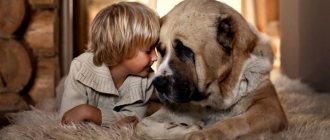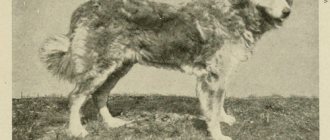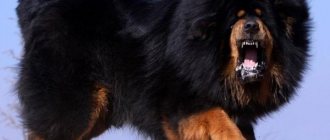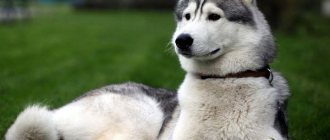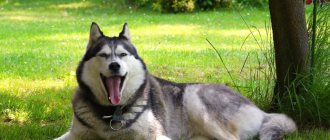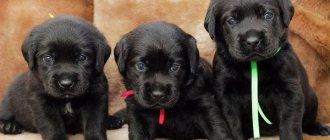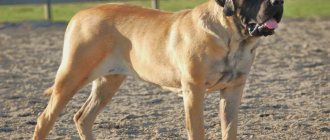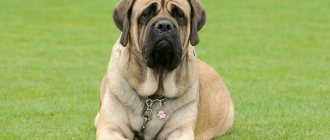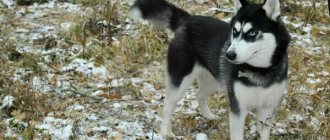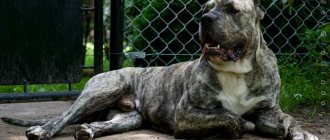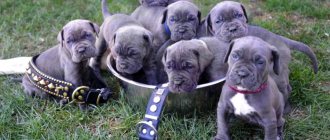Appearance of the English Mastiff
General impression
The English Mastiff has a proportional appearance and a distinct gender type: males are large, massive, and females are lighter and more graceful. In the photo, the English Mastiff looks like a real athlete.
Head
The mastiff's head has a square outline.
Well-developed muscles are noticeable in the parietal, temporal and buccal regions. The skull itself has smooth outlines. If there is a protruding forehead and eyebrow arches, there is a smoothed occiput. The mastiff's muzzle is rectangular in shape and has a circumference 2.2 times smaller than the circumference of the head. Cheekbones are virtually absent. The cheeks protrude slightly due to their roundness. The nose is flattened and painted black. The nostrils are large and wide, mobile. The lips of mastiffs are closer to a rectangular shape, they are thick and fit tightly to the jaws. On the dog’s face you can see a kind of “mask”, characteristic only of this breed.
The animal's ears are adjacent to the cheeks on both sides. They are thin, medium in length and located on the top of the head.
The look of an “Englishman” from the outside may seem soft due to the setting of the eyes - low and wide. The iris is always hazel-colored and can have light or dark shades.
The jaws are square-shaped, and therefore the mastiff has a straight or scissor bite. Teeth are white. The lower incisors grow in a checkerboard pattern, and the canines, on the contrary, are widely spaced, so when the jaw is clenched, the teeth are not visible.
The mastiff's neck is slightly extended forward and has a diameter 2-3 cm less than the diameter of the skull. Thick skin in the throat area forms folds.
Torso
The English Mastiff has a long and powerful body. His chest is represented by convex ribs. The dog's back is wide and originates from the withers. The loin rises slightly above the back and there is a sloping croup. The abdomen and groin area are retracted.
Forelegs
The mastiff's front paws are spaced far apart. A small angle is formed between the chest and the elbow line. The slanted shoulders then flow into steep forearms and large pasterns. The front paws are powerful and round in shape with gathered toes.
Hind limbs
The English Mastiff's thighs are muscular and the shins are dry. Well defined joints. The hind legs are arched and have toes gathered into a ball.
Tail
The dog's tail is sickle-shaped, set high and tapered towards the end. At rest, the tail reaches the hock joints, and during movement it is at the level of the back.
Movements
The Mastiff primarily trots, but can gallop as speed increases. He moves freely, but sometimes his movements look loose. The back is always straight, regardless of the speed of movement.
Wool
The hair of the representatives of the breed is short, but quite thick. Compared to the undercoat, it is hard to the touch.
Color
English Mastiff colors always have tan. The color of the coat can be different: yellowish-brown, fawn, apricot, silver or brindle. The ears and “mask on the face” are always black, despite the general color of the coat.
Size
Females can grow up to 69 cm at the withers, while the male English Mastiff is taller and can reach 75 cm. The body weight of dogs reaches 69 kg in females, 87 kg in males.
The heavy weight of English Mastiffs puts a lot of stress on the joints, which is a reason to regularly take your pet to the veterinarian. The size of the English Mastiff is truly gigantic, and this must be taken into account when arranging a place in the house or in the yard.
Character of the English Mastiff
The English Mastiff is considered a calm, friendly dog. He is not characterized by mood swings. The dog is patient, the character of the English Mastiff is emotionally stable and reliable. The behavior shows nobility and the absence of puppy pranks. Being phlegmatic in behavior, he is devoted to his owners.
Mastiffs are considered true companions. Loneliness is hard to bear. During a prolonged absence of the owner due to idleness and boredom, they can cause damage to the home. It is important to understand: if you have a job that takes a lot of time, or if there is frequent travel (travel, business trips), it is better to refrain from adopting this breed.
The “English” are equally comfortable staying in an apartment and in a private house. They are not characterized by fuss and haste. During walks, mastiffs walk slowly, rarely running. You don’t need to use a leash - the dog will be nearby. Mastiffs are good guards, protecting territory and family members. It is not common for them to attack first, but this is not required.
The impressive appearance of the dog speaks volumes, and the stranger will be driven into a corner, where he will remain until the owners arrive. During a fight (if one happens), the dog will not concede victory to the enemy at the cost of his own life.
Dogs are wary of unfamiliar people and closely watch strangers. The only thing that the owner will have to compete for with a puppy or adult at home is a sleeping place. The main feature of the breed is its preference for comfort. Mastiffs climb onto the owner's sofa to rest without permission.
Families with small children should refrain from owning an English Mastiff for various reasons. Firstly, this is due to the size of the animal: during play, it can accidentally injure a child. Secondly, the dog’s jealousy. In this case, it is better to get a Bichon Frize, Poodle or Airedale Terrier. These breeds are compact and will not cause serious harm, content to play even with small children.
If other animals live in a house with Molosser representatives, it’s okay. The “English” can easily put up with cats, rodents, and birds. Aggression may appear if another pet was adopted much later. In this case, you need to be careful because of the danger of a conflict between the dog and the “rival”; this could end in the death of the other.
The English Mastiff needs to be walked for a long time in any weather and time of year. It's hard to get them to run. In winter, at low temperatures, they feel comfortable thanks to their thick undercoat and are in no hurry to go home. However, in the summer heat, it is better to avoid prolonged exposure to the sun to prevent your dog from overheating.
When choosing a pet, it is important to remember that the character in the future depends on the training and upbringing of the owner. The main goal is to raise a peace-loving and balanced animal that will be a loyal friend.
Education and training
It is important to start raising and training an English Mastiff earlier, preferably in the first days of the pet’s arrival at home. In the process of raising a dog, it is necessary to learn who is in charge in the family - and this is the owner, but not the dog. It is not permissible for a trained “Englishman” to be willful or show aggression. When conducting training, avoid cruelty and physical punishment; on the contrary, use affection and tenderness. The most important thing is to find a middle ground.
Mastiffs perform differently in training. Dogs may want to please the owner and remember the exercise with lightning speed - or become stubborn. Be sure to reinforce the material you have learned, constantly praise and encourage your pet for its success. Training should not last more than an hour or be for your entertainment. Mastiffs will quickly understand this and stop listening to you.
Do not forget that representatives of this breed have good intelligence, and they easily find a weak point in the owner and then manipulate him. Therefore, if some problems arise, it is better to contact a professional trainer.
Training
Representatives of this breed are easy to train. However, due to some features of their character, raising French Mastiff puppies should be done immediately after purchase. But first, the baby needs to be given time to adapt to new living conditions and get used to the owners.
During the training process, you should not scream or show cruelty. With this kind of treatment you will ensure that the dog becomes afraid of you. With the right systematic approach, a small puppy will quickly grow into a wonderful companion and reliable protector.
English Mastiff Health and Diseases
Possible diseases
The English Mastiff has good health and a long life expectancy. But they also have weaknesses. The most common diseases include:
- Joint damage (hip dysplasia, knee osteoarthritis). This is due to their structure and heavy weight.
- Diseases of the gastrointestinal tract (volvulus of the intestines and stomach, obstruction, bloating). Flatulence is the most common problem in this breed.
- Diseases of the cardiovascular system (stretching of the heart walls).
- Diseases of the urinary system (urolithiasis).
- Diseases of the organs of vision (eversion and entropion of the eyelid, redness of the eyes, cataracts). These features are related to the location of the eyes.
If symptoms of the disease appear in your pet, you should not self-medicate, but rather consult a veterinarian. This will improve the health and prolong the life of your pet.
Reproductive health
Bitches come into heat quite early: from 6 to 12 months.
But full puberty occurs only at two years of age - it is from this time that a dog can be bred to produce offspring. The same applies to males - the first mating should not occur too early. Labor in mastiffs can last from several hours to a day, this is normal. Protect newborn puppies from excessive attention from the mother - she can torture them and the offspring will die.
Health
Let us immediately note that the life expectancy of these large beautiful dogs usually does not exceed ten years. In general, they are in good health, but, like any living organisms, they are prone to various diseases.
Most often, French Mastiffs are diagnosed with joint problems. They are prone to skeletal growth abnormalities and arthritis. They also often experience flatulence, cardiovascular problems, lymphoma, cancer, hyperkeratosis, gastric volvulus, epilepsy, kidney failure, ear infections and heat intolerance.
Features of feeding and diet
The English Mastiff has an impressive size and a good appetite. This is financially very costly. There are two types of diet:
- ready-made food – contains the necessary microelements and vitamins for proper nutrition and development;
- natural food.
In the latter case, it is important to develop a pet menu taking into account the addition of necessary microelements. Additionally, you need to choose a vitamin-mineral complex.
It is impossible to combine two diets at the same time (i.e., alternate food and natural food). This will provoke dysfunction of the gastrointestinal tract and negatively affect the dog’s health.
How many times a day should you feed your dog? It depends on age:
- puppies up to 4 months are fed 5 times a day; babies aged 4 to 6 months – 4 times a day; from 6 months to 1 year, feed 3 times a day;
- Adults feed 2 times a day.
It is necessary to exclude sweets, smoked meats, beans, mushrooms, berries containing seeds, boiled or raw river fish, tubular bones, lamb, pork, and milk from the pet’s diet (allowed for puppies up to 4 months).
Do not add spices to your dog's food and try not to give treats from the table. The mastiff should have access to unboiled water. Most breeders are inclined to believe that bottled water is preferable.
Care and maintenance
Keeping and caring for English mastiffs is quite simple and does not require special skills, and all thanks to the dog’s short hair. The pet must be brushed once every 2-3 weeks. During the shedding period, you will have to brush more often using a stiff bristle brush. To add shine to the coat, you can use a cloth or a piece of suede and periodically wipe the sides and back of the dog.
The animal is bathed rarely and, if necessary, using special pet shampoos, so as not to provoke hair loss and skin irritation. For more frequent care, you can use dry shampoo.
It is very important to keep your pet's face clean. Carry out regular eye examinations, wipe with a solution of chamomile or strong tea. If discharge of any color appears from the eyes, you should contact your veterinarian.
After a walk, ears should always be wiped with a damp cloth and inspected. Using a damp cotton pad or soft cloth, you need to regularly clean the folds on the face and neck: food particles, dust, grease, and dirt can accumulate there.
It is recommended to clean your teeth and oral cavity once a week using a toothbrush, a special finger attachment, or a bandage folded in several layers. Claws must be periodically removed with pruning shears, even though dogs' claws wear down when walking under heavy weight.
Mastiffs need long walks, but in hot weather it is better to reduce the time spent in the sun to a minimum, since mastiffs have a brachycephalic muzzle, which makes it difficult for the dog to breathe and can lead to overheating of the body.
Tips for choosing a puppy
To purchase a puppy with good health and genetics, it is better to contact an official nursery. The most important criterion for choosing an English Mastiff dog is character. If there are children in the family, it is better to purchase a puppy with a less dominant character, so that the child and the dog do not compete for authority and love in the family. It must be remembered that an overly timid character in a dog is not the best sign.
This rule must be taken into account by families who already have pets, including dogs. In such a situation, it is better to take a puppy of the opposite sex. Mastiffs with a dominant type of character can only be handled by owners who have experience in keeping large breed dogs and who know how to approach them. It is important to remember that love and proper training will turn even a born leader into an obedient and friendly pet.
The best age to buy a baby is from 1.5 to 3 months. At this time, English Mastiff puppies have a stable psyche and are ready for independent life.
Dog handlers recommend that before choosing and buying a puppy, you study the conditions of its keeping, look at the parents, check documents and vaccination certificates. A healthy puppy should have shiny fur, clear eyes, and a cool and moist nose. If you are in doubt about your choice, it is better to consult a dog handler, since the cost of these dogs is rather high.
How much does a French Mastiff cost and how to choose a puppy?
If you definitely decide to get yourself a representative of this breed, then it is better to contact a specialized nursery that professionally breeds Dogue de Bordeaux. This is the only way you will be sure that the dog you have chosen is completely healthy and has no pathologies. It is advisable that the parents of the baby you like have all the documents confirming their origin. It’s good if they have training diplomas, show titles and awards.
When choosing a Dogue de Bordeaux puppy, you need to pay attention to its behavior and appearance. He should be cheerful, playful and active. It is important that the baby does not show the slightest signs of cowardice or aggression. A healthy puppy should have a soft belly, shiny fur, and clean eyes and ears.
Those who are interested in how much a French mastiff costs, the description of which can be found a little higher, need to understand that this figure depends on several important factors. But usually the price for such dogs ranges from $150 to $3,000.
How much does an English Mastiff cost?
The price of an English mastiff depends on many factors, and the average amount starts from 30,000 rubles. The price is influenced by the gender of the dog, compliance with standards, the location of the nursery, pedigree and degree of title of the parents are taken into account. Cull puppies that will not participate in dog shows are sold for a small price.
At the same time, the price of a puppy with a good pedigree and titled parents skyrockets. Here you need to decide for what purpose the animal is needed: to participate in exhibitions or just as a friend.
In any of these two cases, you will not lose, since you will have a pet that will brighten up your everyday life and become a favorite of the whole family.
Vices and shortcomings
Since the price of the French Mastiff is quite high, you need to carefully study the breed standard before purchasing it. Especially when it comes to purchasing a dog for exhibitions. This document clearly states all the shortcomings and vices that do not allow the dog to participate in breeding.
The official standard does not allow a short round head with prominent eyes, lateral deviation of the lower jaw, arched back and flat hips. Serious faults include turned-out front legs, close or barrel-shaped hind legs, short wheezing, and too much or too little stifle angle.
The French Mastiff should not have a long, narrow head with poor compression, a Roman nose and a twisted jaw. Animals with atrophied, curled, knotted or horizontally deflected tails are not allowed to participate in exhibitions. Disqualifying faults include fangs that are constantly visible when the mouth is closed, a tongue hanging out of a closed mouth, and paws that are turned outward. Dogs with white spots on the head or tip of the tail, as well as individuals with a non-standard color, are not used in breeding.
